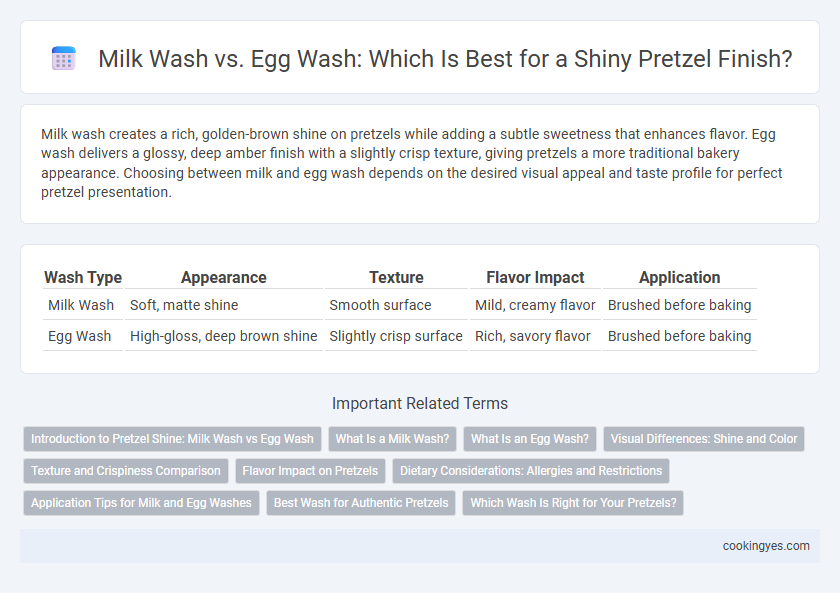Milk wash creates a rich, golden-brown shine on pretzels while adding a subtle sweetness that enhances flavor. Egg wash delivers a glossy, deep amber finish with a slightly crisp texture, giving pretzels a more traditional bakery appearance. Choosing between milk and egg wash depends on the desired visual appeal and taste profile for perfect pretzel presentation.
Table of Comparison
| Wash Type | Appearance | Texture | Flavor Impact | Application |
|---|---|---|---|---|
| Milk Wash | Soft, matte shine | Smooth surface | Mild, creamy flavor | Brushed before baking |
| Egg Wash | High-gloss, deep brown shine | Slightly crisp surface | Rich, savory flavor | Brushed before baking |
Introduction to Pretzel Shine: Milk Wash vs Egg Wash
Achieving the perfect pretzel shine depends largely on the choice between milk wash and egg wash, each imparting distinct textures and hues. Milk wash contributes a soft, golden gloss, enhancing the pretzel's surface with subtle creaminess, while egg wash offers a richer, deeper shine with a slightly crisp finish. Understanding the chemical interactions between these washes and the dough's Maillard reaction is crucial for bakers aiming to create visually appealing and flavorful pretzels.
What Is a Milk Wash?
A milk wash, commonly used in pretzel baking, involves brushing the dough with milk before baking to achieve a soft, tender crust with a subtle sheen. The natural proteins and sugars in milk caramelize during baking, enhancing the pretzel's color and providing a slightly glossy finish compared to the more intense shine from an egg wash. This method is preferred for pretzels aiming for a mild, golden-brown appearance without the strong flavor or high gloss typically produced by egg wash.
What Is an Egg Wash?
An egg wash is a mixture of beaten eggs, sometimes combined with water or milk, brushed onto pretzel dough before baking to create a glossy, golden-brown crust. The proteins and fats in the egg wash enhance Maillard browning and contribute to a shiny, appetizing finish. Compared to milk wash, an egg wash typically yields a richer color and more pronounced shine on the pretzel surface.
Visual Differences: Shine and Color
Milk wash gives pretzels a subtle, matte shine with a golden-brown color, enhancing a soft, warm appearance. Egg wash creates a glossy, deep amber finish, resulting in a richer and more polished look. The choice between milk and egg wash significantly impacts the pretzel's visual appeal by altering its shine intensity and crust color.
Texture and Crispiness Comparison
Milk wash enhances pretzel shine by creating a soft, slightly glossy crust while maintaining a tender texture. Egg wash produces a higher sheen with a more pronounced, crisp exterior due to the proteins and fats that promote browning and firmness. Texture-wise, milk wash results in a gentler crust, whereas egg wash delivers a distinct crunch and robust crispiness.
Flavor Impact on Pretzels
Milk wash imparts a subtle sweetness and tender crust to pretzels, enhancing their rich, buttery flavor without overwhelming the dough's natural taste. Egg wash creates a glossy, deep brown finish with a slightly savory note that intensifies the pretzel's traditional flavor profile. Choosing milk wash or egg wash influences not only the appearance but also the flavor depth and texture, tailoring the pretzel experience.
Dietary Considerations: Allergies and Restrictions
Using a milk wash on pretzels enhances shine while posing concerns for individuals with lactose intolerance or dairy allergies, requiring a dairy-free alternative. Egg wash delivers a rich, golden finish but can trigger allergic reactions in people with egg allergies and is unsuitable for vegan or strict vegetarian diets. Choosing between milk and egg washes depends on balancing desired pretzel appearance with dietary restrictions like lactose intolerance, egg allergies, and vegan preferences.
Application Tips for Milk and Egg Washes
Applying milk wash to pretzels creates a subtle, golden-brown finish that enhances softness while egg wash delivers a deep, glossy shine with a slightly crisp texture. For milk wash, brush the pretzels lightly before baking to avoid sogginess, ensuring even coverage without pooling. When using egg wash, beat the egg with a tablespoon of water or milk for smooth application and apply it evenly with a pastry brush to prevent streaks and blistering.
Best Wash for Authentic Pretzels
Egg wash is traditionally preferred for authentic pretzels, providing a rich, golden-brown shine and a slightly crisp texture. Milk wash offers a milder sheen and softer crust, often used for softer pretzels or variations. For the signature glossy finish and characteristic crunch, egg wash delivers the best results in pretzel baking.
Which Wash Is Right for Your Pretzels?
Milk wash imparts a subtle sheen and soft texture to pretzels, enhancing their golden-brown color without altering the flavor significantly. Egg wash creates a glossy, deep amber finish with a slightly firmer crust, ideal for pretzels seeking a traditional bakery appearance. Choosing between milk and egg wash depends on desired pretzel aesthetics and texture preferences, with milk wash offering a softer shine and egg wash providing a bold, shiny glaze.
Milk Wash vs Egg Wash for Pretzel Shine Infographic

 cookingyes.com
cookingyes.com